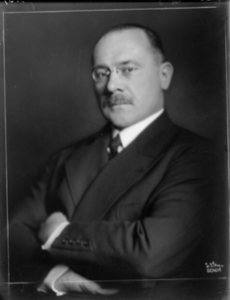Milan Hodža (1878-1944), Slovak journalist, historian and politician.
© Article written by Gabriel Godeffroy for the Central Europe Foundation
Photo: D’Ora Benda, “Milan Hodža”, 1929, Österreichische Nationalbibliothek.
After studying Law in Kolozsvár (today Cluj-Napoca) and Budapest, Milan Hodža started his professional career as a journalist. In 1905, he was elected Member of the Hungarian Parliament in Budapest, as representative of the Slovaks and the Serbs of the Banat region. During his mandate, Hodža advocated cooperation between the Slovaks and the Czechs, and created the “nationalities club”, which gathered Slovak, Serbian and Romanian Members of Parliament. At that time, he was also a member of the “Belvedere Circle” of Archduke Franz Ferdinand, the heir to the throne, and worked on the transformation of the Habsburg Monarchy into a federation of nation states. During the First World War, he completed his doctorate in Philosophy at the University of Vienna.
After the collapse of Austria-Hungary, Milan Hodža was involved the creation of the new Czechoslovak state and became the representative of the Czechoslovak government in Budapest. From 1920, Hodža was a Member of the Chamber of Deputies of the Czechoslovak Parliament for the Agrarian Party. In 1921, he was also appointed Professor in History at the University of Bratislava. During the interwar period, he was Minister on several occasions: Minister of Agriculture from 1922-1926 and from 1932 to 1935, as well as Minister of Education from 1926 to 1929.
As Minister of Agriculture, Milan Hodža wanted to solve the Central European agricultural crisis by promoting economic cooperation between the Successor states of Austria-Hungary. After Adolf Hitler’s rise to power, Hodža was a strong advocate of economic rapprochement between the Danubian states, in line with the ideas of Elemér Hantos. As President of the Czechoslovak government from November 1935, with the Portfolio of Foreign Affairs, he strove, in vain, to reach an agreement with the other Successor States of Austria-Hungary.
After the Munich Agreement in September 1938, as his government was forced to resign, Milan Hodža went into exile in Switzerland, later in France and in the United Kingdom, and finally in the United States, where he published his famous book Federation in Central Europe: Reflections and reminiscences in 1942.
--Anton Štefánek, “Milan Hodža” (Prager Presse, 1. Februar 1928, S. 1-2)
--"Mitteleuropäische Köpfe: Milan Hodža“ (Die Börse: Wirtschaftszeitung für Mitteleuropa, 16. Januar 1936, p. 3)
--“Dr. Milan Hodža” (Die Stunde, 1. Februar 1938, p. 2)
Click here for full biography in Wikipedia.

